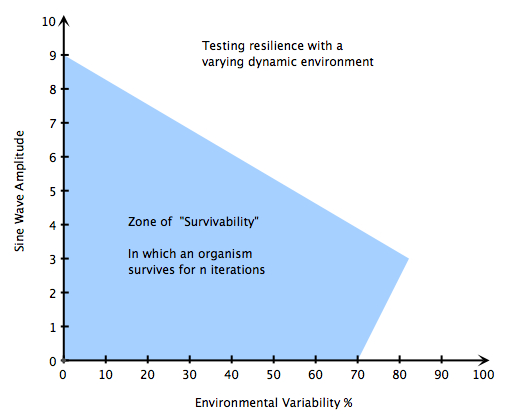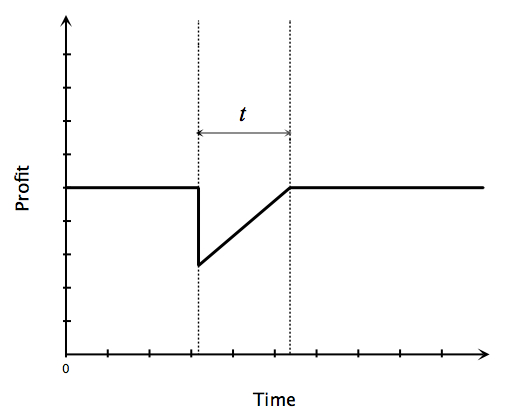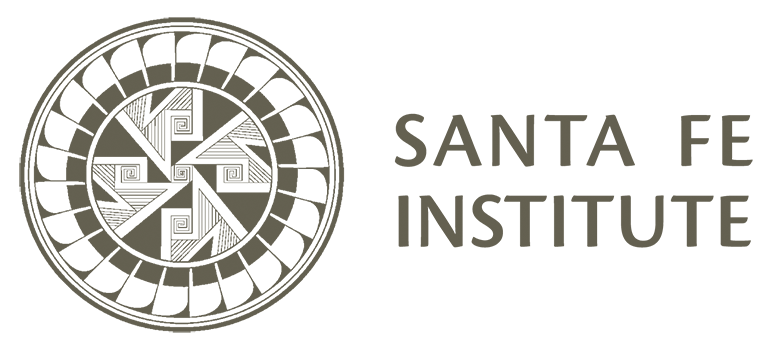Organizational adaptability and robustness in dynamic environments
From Santa Fe Institute Events Wiki
Thought this would be a good place to add any thoughts/ ideas between meetings and also to perhaps place any interesting points from the literature that you have found so everyone is up to speed but doesn't neccesarily have to read everything! Richard.
People Involved
Cathy Spence
Steve Hall
Richard Streeter
Jiang Wu
Bradley Jones
Shawn Barr
Ideas/ Brainstorming
A lot depends on getting hold of the model from Josh.
- Add a cost for changing hierachical structures
- Investigate which 'genome' is a) most agile and b) most robust. Are a and b the same?
- Look at case studies - model exploration using civilization examples
- Model improvement - Incorporate more sophisticated dynamic environments - possibly some sort of feedback mechanism (based on models of resource use and growth?) and/or more 'realistic' fixed environments
- Can we incorporate 'network' structure?
Learn: How process to generate structure and environment affects viability and performance. What is the tradeoff between surviving in the long term and making as much money as possible in the near term.
I think it would be good to test the hypothesis - does increasing efficiency (profit) always decrease the resilience (ecological) of the system? Richard
Model Ideas
Testing resilience
Option A
We define a number (10, 20?) of different static environments, E, ranging from lots of resources, few resources, high inter-anual variability and perhaps even some with a stochastic element. Each organisational genome is then tested n times against each environment, and can either survive (pass) or fail (die). The genome that passes the highest number of E is the most resilient to the widest possible range of inputs (but will probably not be the most efficient for most of them).
Option B
The environment is given two variables, r, which is the lowest possible value of resources coming in and variabilty, v which could be defined as the average (stochastic) change in a system over a time period we define (a certain number of model ticks). For each genome we paramater sweep r and v. An organisation can either live or die. This will give us a range of r and v values for each genome in which the system did not fail. The system with the largest range of input values is the most resilient. Plotting r and v on a xy axis would define an area in which a the system could absorb inputs, and this area is equal the the resilience value R. It would be interesting to investigate if there were some genomes that had a slightly smaller resilience value, but overall much higher efficiency (measured by gross profit over the time of the simulation?).
The result may look something like this for each particular 'genome'.

Testing Agility
Each genome starts in a static environment a in which the profit from the resources has reached its maximum (i.e. the system is in equilibrium). Then the environment changes to a second state b. The time t taken for the genome to reach its maximum potential output (i.e. no nodes are missing any oppertunities) is a measure of the agility. The smallest value of t is the most agile organisational genome.
Fitness with respect to what?
Here I propose some definitions of what we are testing robustness and agility against...(Richard)
So when a system is stable it is with respect to profit (or alternatively the bank balance?).
When a system is robust, it is with respect to whether or not the bank balance goes below $0.
When an organism is agile, it has the smallest possible t when changing from equilibrium with respect to a stable environment a to a new stable environment b. The measure of stability is the profit (or perhaps bank balance?) of the organism.
We are testing its robustness with respect to the number of nodes (amplitude of perturbation) removed from the structure, with the measure of the time t it takes to return the maximum possible output within the new system.
We are testing its resilience with respect to the variation in the environment against the measure of does this organism survive over n iterations?
Definitions
Adaptability - see wikipedia In the model the only difference I can see with this and robustness is that with one we take out nodes, and the other we change the environment from one static state to another. The measure in both cases is the same, the time t taken to reach equilibrium again.
Robustness - also wikipedia The time t after a shock to the system in which it takes to reach equilibrium again. The shock is taking out nodes.

This is the definition which i think is useful (cut and paste from wikipedia):
Ecological resilence: When a system can reorganize, that is shift from one stability domain to another, a more relevant measure of ecosystem dynamics is ecological resilience. It is a measure of the amount of change or disruption that is required to transform a system from being maintained by one set of mutually reinforcing processes and structures to a different set of processes and structures. The second definition emphasizes conditions far from any steady-states, where instabilities can flip a system into another regime of behavior - i.e. to another stability domain. In this case resilience is measured by the magnitude of disturbance that can be absorbed before the system changes its structure by changing the variables and processes that control behavior. This type of resilience has been defined as ecological resilience.
There is also the 'engineering' definition of resilience: concentrates on stability near an equilibrium steady-state, where resistance to disturbance and speed of return to the equilibrium are used to measure the property.
Certainly when considering past societies the first definition is more interesting and useful, but perhaps harder to model? Perhaps we could consider which organizational 'genome' has the largest 'stability domain' as an approach to understanding robustness?
Adaptive Capacity could be a key concept to consider here.
This article has a good definition I think [http://www.ecologyandsociety.org/vol9/iss2/art5/ Resilience Adaptability and Transformability in Social– ecological Systems]
Organizational Agility - power to the edge wikipedia
Agile enterprise--from the viewpoint of complex adaptive system -see Agile enterprise -Jiang
For the purposes of computer modeling, (given the many differing definitions of agility and robustness) it may be helpful to restrict the definitions as follows:
Agility: involves the ability of the system to exploit profitably opportunities in a volatile marketplace, and is dependent on the variables presented by that marketplace. This would relate to the attackers/opportunity flux in Josh's model.
Robustness: involves the ability of the system to survive variations in structural/internal parameters without disrupting its behavior. This would relate to loss of nodes in the company, cost of loss and cost/delay in replacing the nodes. This does have an effect on the agility as a secondary consideration. (Brad)
Resources/ Literature
Download this file and change the file extension to nlogo to use it in netlogo: model version 6.5
This is an update of version three augmented with an enhanced 'opportunities' generator. model version Adaptive_orgs_3_withGenerator. Download and change extension to .nlogo
This is the version with changing of the color Adaptive_orgs_3_withGenerator_-_Jiang0624
This is Josh's presentation on Growing Adaptive Organizations
This book is about agile organzation, how to manage information network in the organzation from the viewpoint of complex adaptive system.(THE AGILE ORGANIZATION) -Jiang
Dynamic Organizations: Achieving Marketplace And Organizational Agility With People
Information exchange and the robustness of organizational networks
STABLE OR ROBUST? WHAT'S THE DIFFERENCE?
The Science of Self Organization and Adaptability
Limits of prediction in modeling social systems
COMPLEXITY RISING: FROM HUMAN BEINGS TO HUMAN CIVILIZATION, A COMPLEXITY PROFILE
Definitions, Measures, and Models of Robustness in Gene Regulatory Network
An Examination of a Firm’s Adaptive Behavior and its Network Structure
Recommended by Josh:
- Modeling Civil Violence: An Agent-based Computational Approach. Epstein. PNAS 99:3, 7243-7250 (2002).
- Controlling Pandemic Flu: The Value of International Air Restrictions. Epstein, Goedecke, Yu, Wagener, and Bobashev. PLOS One 5, 1-11 (2007).
- Population Growth and Collapse in a Multiagent Model of the Kayenta Anasazi in Long House Valley. Axtell, Epstein, Dean, Gumerman, Swedlund, Harburger, Chakravarty, Hammond, Parker, and Parker. PNAS 99:3, 7275-7279 (2002).
- Coupled Contagion Dynamics of Fear and Disease: Mathematical and Computational Explorations. Epstein, Parker, Cummings, and Hammond. SFI Working Paper 07-12-048 (2007).
Societal robustness and dynamic environments - the long term view
O'Suliven (2008) - 'The Collapse of Civilizations: what palaeoenvironmental reconstruction cannot tell us, but antrhopology can'
This article I think is excellent and suggests a number of interesting points. Especially consider that he suggests that minimizing hierarchy can maximize long-term sustainability.
Scheffer and Westley (2007) The Evolutionary Basis of Rigidity
Good points to note from this article are the concept of the 'efficiency trap' which may limit adaptive capacity
Diamond (2005) Collapse - A useful synthesis but pretty simplistic. Interesting comparison between so called top-down success and bottom up success.
Panarchy is a concept that is becoming widely used in my area - I have the 'Panarchy' book and it has a chapter entitled The Devil in the Dynamics: Adaptive Management on the front lines - I will report back when I have read it.
Walker et al (2004) [http://www.ecologyandsociety.org/vol9/iss2/art5/ Resilience, Adaptability and Transformability in Social ecological Systems]
Janssen et al (2003) Sunk Cost effects and Vulnerability to collapse in Ancient Societies - we could perhaps apply some of the ideas/ formulas here for resources/population equilibria and how this varies when there is investment in structures (organizational structure?). There is also a resource use function we could utlise to incorporate feedback for the environment.
see also [http://www.ecologyandsociety.org/vol9/iss1/art6/ Overexploitation of Renewable Resources by Ancient Societies and the Role of Sunk-Cost Effects]
I will try and dig out some case studies from human settlement in the North Atlantic and also in the pacific where a lot of work has been done. I also will try and find some information on the surplus cost of maintaining a complex hierarchical structure in past societies - there are some leads in the O'Suliven article to follow.
